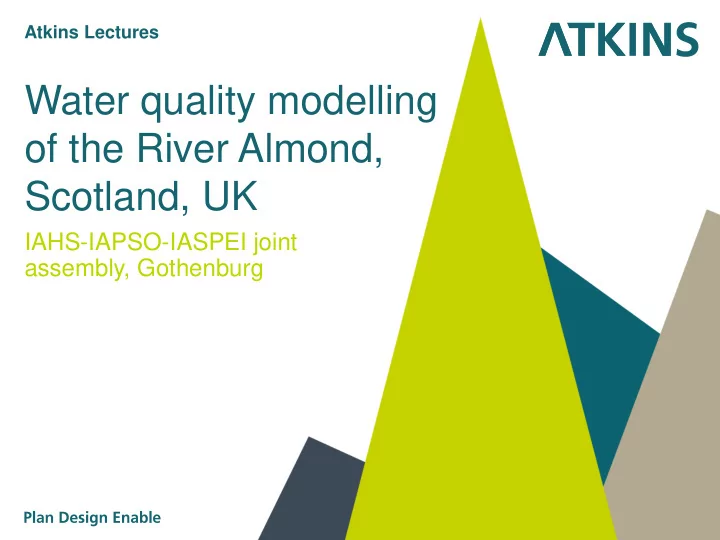

Atkins Lectures Water quality modelling of the River Almond, Scotland, UK IAHS-IAPSO-IASPEI joint assembly, Gothenburg
Vera Jones, senior environmental scientist, Water and Environment 25 July 2013
Introduction Background to the project
Catchment understanding at the start of the project River Almond, SE Scotland Large part of the flow from wastewater discharges and untreated discharges from combined sewer overflows Pollution from septic tanks and other private discharges Diffuse pollution pressure associated with historic mining A number of surface water outfalls – industrial estates.
Key objectives of this study Water quality survey and development of a modelling tool Help to assess the impact of Scottish Water assets on the water quality of the River Almond and its tributaries Development of strategic options to meet requirements of the Water Framework Directive and the Urban Wastewater Treatment Directive.
Study area Cramond Weir Summer 2011 survey Upper boundary
Modelling Model development, calibration and validation
Model description (Mike 11 Ecolab by the DHI Group) Biogeochemical interactions Air temperature, air humidity, wind speed Advection/dispersion Time Time Time Time Time Time Heat Space Space Space Space Space Space Advection Advection Dispersion Dispersion Hydraulic model d[BOD]/dt= - BOD Decay - Sedimentation + Resuspension Photosynthesis = Pmax*suninp/depth Respiration= DO2/(DO2+ mdo)*resp* teta2(TEMP-20)/depth
Model description Biogeochemical interactions Determinants modelled: Dissolved oxygen Temperature Advection/dispersion Ammonia Nitrate Ortho-phosphate Particulate Heat phosphorus Biochemical oxygen demand Hydraulic model
Model description Biogeochemical interactions Boundaries: 31 rural sub- catchments Advection/dispersion Seven wastewater treatment works Six private Heat discharges ~120 combined sewer overflows – modelling by MWH Hydraulic model
Calibration and validation summary temperature ( ºc)
Calibration and validation summary Excellent match when considering daily average temperature
Calibration and validation summary Key parameter in this study: overall good match with observed data
Calibration and validation summary Some spikes in the model record – potentially high values not picked up by the monitoring
DO% saturation 160 Crucial to fish Many interactions with other parameters 140 Model 120 DO% Observed observed 100 80 modelled Max: day 60 40 20 0 Min: night 15/08/2011 20/08/2011 25/08/2011 30/08/2011 04/09/2011 09/09/2011 14/09/2011 19/09/2011 24/09/2011
Methodology for the needs assessment
Methodology for needs assessment 10-year runs – stochastic ‘baseline’ Two years selected for further scenario testing : ‘poor’ and ‘average’ water quality Results extracted and processed for every model node: • Water Framework Directive standards Urban • 99th percentile (99 th ile) standards* Wastewater • Fundamental Intermittent Standards (FIS)* Treatment Directive *FWR (2012). Urban Pollution Management Manual http://www.fwr.org/UPM3/
Methodology for needs assessment Programme developed for processing results at every node against the relevant standards. Output in a suitable format to produce maps of classification at model node. High Good Moderate Poor Bad For all results analyses: Good or High Status is required.
Needs assessment: stochastic ‘baseline’ runs
Results of needs assessment: summary High Good Moderate Poor Bad Summary of 10-year baseline stochastic runs: • No FIS failures • WFD failures for ortho-phosphate and ammonia • 99 th ile failures for ammonia and BOD Ammonia – WFD assessment (10-year)
Needs assessment: scenarios runs
Results of needs assessment: analysis against WFD standards Wastewater Treatment Works (WwTW) discharges Ortho-phosphate 2024 – no waste Ortho-phosphate 2024 - baseline High water treatment works scenario Good Moderate Works are a key cause of failure to meet the Water Framework Poor Directive standards Bad
Results of needs assessment: analysis against 99 th ile standards Wastewater Treatment Works (WwTW) discharges BOD 2024 – no waste water treatment BOD 2024 - baseline works scenario High Good Moderate Poor Works dilute intermittent untreated combined sewer overflow inputs Bad
Results of needs assessment: analysis against WFD standards Combined Sewer Overflows Ortho-phosphate 2024 – no combined Ortho-phosphate 2024 - baseline sewer overflows scenario High Good Moderate Small improvement – combined sewer overflows have a small effect Poor on compliance with Water Framework Directive standards Bad
Results of needs assessment: analysis against 99 th ile standards Combined Sewer Overflows BOD 2025 – no combined sewer overflows BOD 2025 - baseline scenario High Good Moderate Combined sewer overflows have a noticeable impact on compliance Poor with 99 th ile standards Bad
Results of needs assessment: analysis against WFD standards “Best Available Technology” Ortho-phosphate 2025 – ‘best Ortho-phosphate 2025 - baseline available technology’ scenario High Good Moderate Best available technology treatment at WwTW is not sufficient to Poor achieve required status Bad
Summary and Conclusion
Summary and Conclusion • The results of the modelling portray a complex picture of water quality dynamics in the River Almond system • Key parameters of concern with regards to the Water Framework Directive and Urban Wastewater Treatment Directive compliance – ortho-phosphate and BOD • Most significant cause of poor water quality: continuous discharges from wastewater treatment works • However wastewater treatment works also have a beneficial effect - diluting the intermittent untreated combined sewer overflow inputs •Operation of key wastewater treatment works at ‘ Best Available Technology ’ treatment levels: not sufficient to bring the whole system to the required status – key for strategic decisions • Assuming the current wastewater load to the system , achieving requirements through investment in wastewater treatment work will be challenging • Model currently being used to test different options – in discussion with the regulator (Scottish Environment Protection Agency) – aiming to achieve best possible ‘balance’ of compliance, also considering impacts on flow.
For more information contact: Vera Jones vera.jones@atkinsglobal.com
Celebrating 75 years of design, engineering and project management excellence. www.atkinsglobal.com
Recommend
More recommend